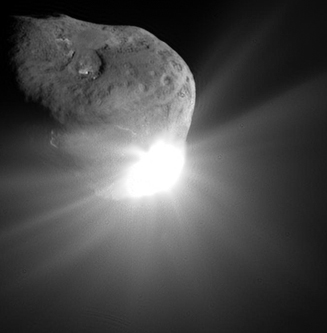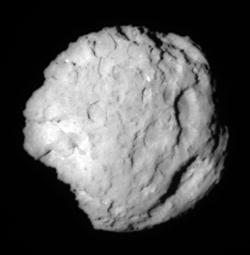
Deep Impact torpedoed comet Tempel 1 on July 4th, 2005 — and exposed materials that no one expected to find.
Selby Cull
When NASA slammed the Deep Impact probe into comet Tempel 1 on July 4th, 2005, researchers were searching for the oldest stuff in the solar system. They thought that, below its altered outer layers, the comet's nucleus might contain ice and dust unchanged since 4.5 billion years ago — our best link to the birth of our solar system.
But when a team led by Carey Lisse (University of Maryland) aimed the infrared Spitzer Space Telescope at the cloud of ice and dust that erupted from the collision, they were surprised. The team reports in the August 4th Science that the Tempel 1 debris was laced with carbonates and clays: two classes of minerals that, on Earth, usually form in the presence of liquid water.
For a comet, liquid water does not mean oceans and rivers. Instead, it implies groundwater or steam seeping through the interior sometime in the past, destroying or altering the original materials within.
"The detection of carbonates and clays is surprising," says Paul Weissman (Jet Propulsion Laboratory), a comet researcher not involved in the Spitzer study. "For some people, this makes comets more interesting, but for me it also means that some of the pristine record we have always touted as being within cometary nuclei may have been lost."
Tempel 1 is the only known comet with evidence of carbonates or clays. In 2004, NASA's Stardust spacecraft flew past the comet Wild 2, collecting tiny motes of dust, which it returned to Earth in January 2006. So far, the Wild 2 samples seem fairly pristine.

In January, 2006, the Stardust mission returned dust grains from comet Wild 2, which, so far, seems to be unaltered.
Selby Cull
"We don't see any evidence of alteration at all," says Stardust Principle Investigator Don Brownlee (University of Washington). "Maybe Tempel 1 and Wild 2 are completely different comets, but we think they are probably more similar to each other than different. They could just have different evolutionary histories."
Although the Spitzer and Stardust observation showed that the two comets are compositionally similar, they are at least superficially different. Unlike Wild 2, Tempel 1 is peppered with impact craters, leading researchers to wonder whether these might be the source of the carbonates and clays.
"We know there's lots of water in the comet," says Lisse. "And Deep Impact did hit between two impact craters. It's possible that those impacts could have created steam, so that the spot where Deep Impact hit was not perfectly pristine. It's not for sure. There's much ambiguity."
Lisse and his colleagues also point out that water is not the only option for producing the minerals. Last year, a team led by Alice Toppani (Lawrence Livermore National Laboratory) showed that carbonates can grow from gases, without liquid water. And other researchers have shown that heating certain minerals in a process called annealing can produce clays — again, no water necessary.
"The party line in planetary geology is that you need liquid water to make carbonates and clays from rock," says Lisse. "But the number of laboratory studies done on their formation at low temperatures and pressures is next to none."
"I certainly hope the material in the comet has been essentially unchanged since it was incorporated 4.5 billion years ago," he adds. "But I think the jury is still out."
 0
0
Comments
You must be logged in to post a comment.